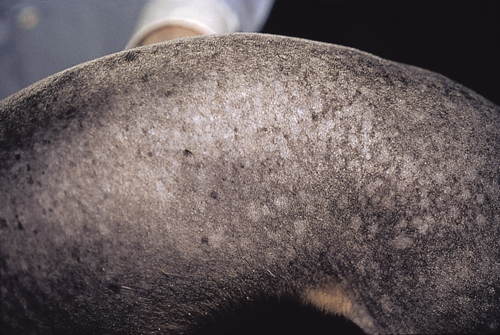Difference between revisions of "Small Animal Dermatology Q&A 16"
(No difference)
| |
Latest revision as of 14:07, 1 August 2011
| This question was provided by Manson Publishing as part of the OVAL Project. See more small animal dermatological questions |
A 2-year-old blue doberman pinscher dog was referred for the problem of an ‘endocrine alopecia’ of unknown etiology. Previous diagnostic tests were normal or negative and included: skin scrapings, dermatophyte culture, complete blood count, urinalysis, serum chemistry panel, thyroid hormone evaluation, low-dose dexamethasone suppression test, and surgical neutering. Dermatological examination reveals a thin hair coat, nodular-like hair follicles, comedones, bacterial pyoderma, and scaling. All of the other littermates are similarly affected.
| Question | Answer | Article | |
| What is the most likely diagnosis, and what is the cause? | Color dilution alopecia (previously called color mutant alopecia). This is a genetic disorder of the hair coat commonly associated with a blue or fawn coat color. The cause is unknown, but it is believed to be due, in part, to a defect in the coat color genes at the D locus.
As hairs regrow, they grow more slowly and are often deformed. This disorder has been seen in cats with blue or cream colored coats. |
Link to Article | |
| How is this disorder treated? | There is no effective treatment for this disorder. In the early stages of the disorder, hair loss is caused by hair shaft fracture. |
Link to Article | |
| What are the most common histological findings? | Common histological findings show melanin clumping in the epidermal and follicular basal cells, macromelanosomes in the hair shafts or hair bulbs, and follicular dysplasia. |
Link to Article | |
